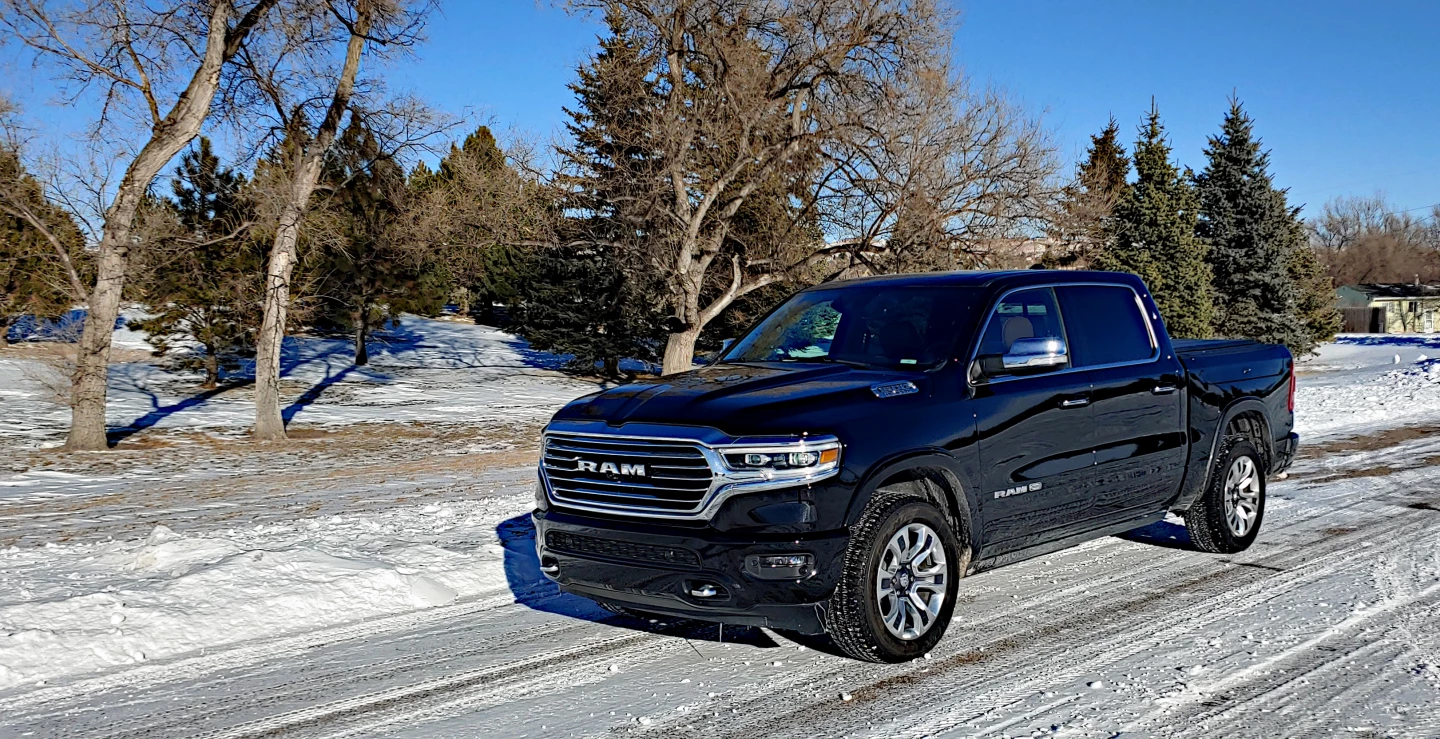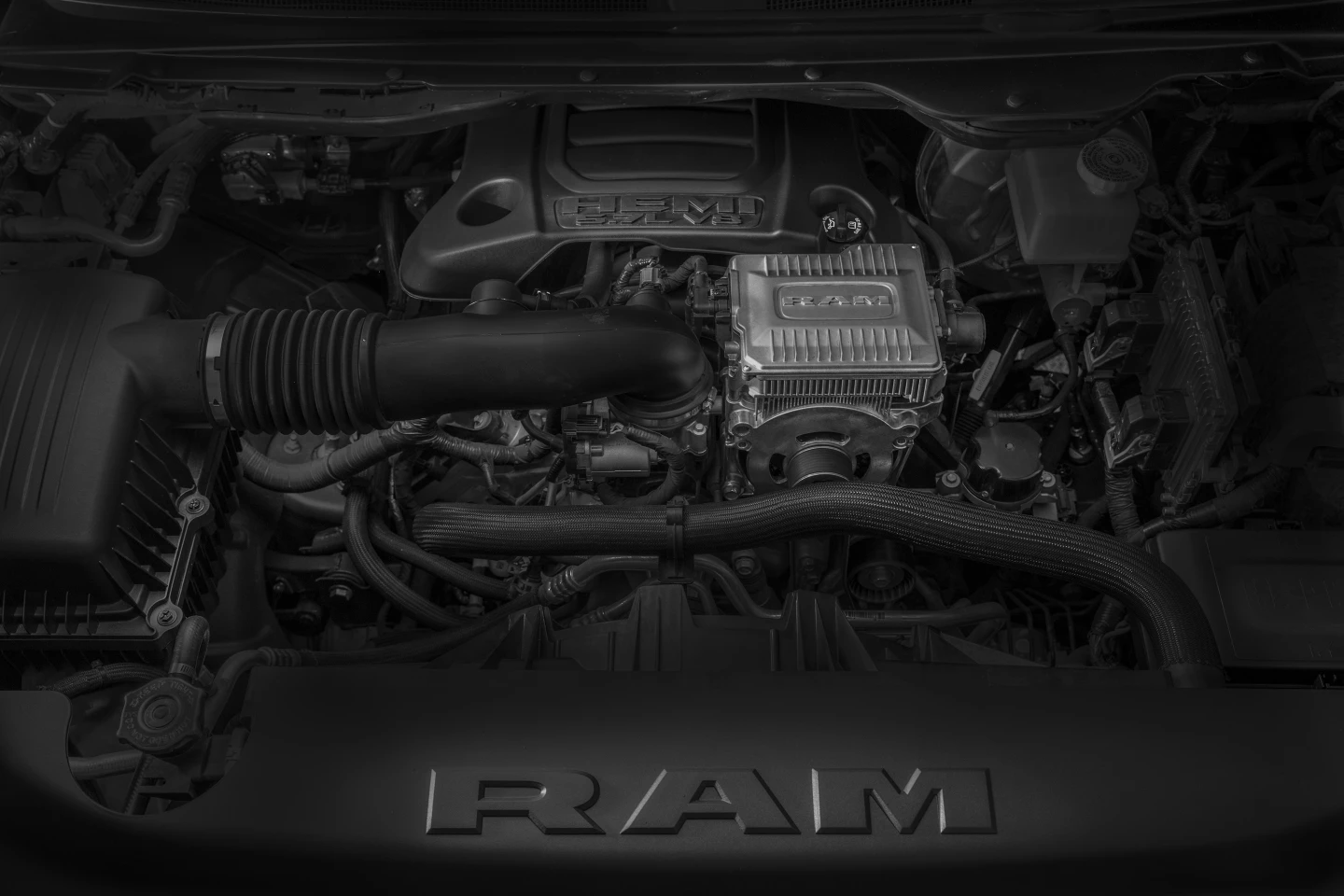Over the past decade, auto manufacturers have improved the handling and fuel efficiency of their pickup truck offerings. The Ram 1500 is one of the major players in this segment and we drove the 2020 model in both of its higher-efficiency powertrain options: the eTorque mild hybrid and the EcoDiesel turbodiesel. These two offer a lot of upgrades for both capability and fuel efficiency. Here’s what we learned.
The fifth-generation Ram pickup in its half-ton 1500 configuration was introduced in 2019. We loved the changes and how the new Ram 1500 handles on- and off-road. For 2020, a few things change as Ram adds a newly-upgraded EcoDiesel engine to the mix. To nutshell it, the eTorque mild hybrid, which is standard in the V6 model and optional on the V8 (as we drove it), improves fuel economy by a couple of points and boosts towing capacity as well. The EcoDiesel option added for 2020 also improves fuel economy and brings more towing capability.
The 2020 Ram 1500 comes in seven different trim levels, most of which can have varied cab configurations, rear-wheel or four-wheel drive, short or long cargo beds, and either the eTorque or the EcoDiesel engine option. We drove the eTorque V8 engine in the near top-end Long Horn edition of the truck and the EcoDiesel in the base model Tradesman package. This gave us not only exposure to both engine options, but also to the impressive breadth in the Ram Truck trim package lineup, all of which are built on the new frame Ram designed for this new-generation truck.

The base Tradesman is still pretty well equipped with its five-inch touchscreen, 4G Wi-Fi hotspot, keyless entry/start, and trailer sway as standard. The most expensive upgrade on our Tradesman package was the US$5,000 upgrade from the base level V6 eTorque to the EcoDiesel engine. The diesel boosts torque from 269 lb-ft (365 Nm) to 480 (651 Nm). It also changes the gas engine’s EPA-rated 25 mpg (9.4 l/100km) highway to a diesel-powered 32 mpg (7.35 l/100km). Those numbers are from two-wheel drive models, adding four-wheel drive lowers fuel economy by about 3 mpg. Our testing of the 2020 Ram 1500 with the EcoDiesel engine proved out those highway numbers at just shy of 32 mpg despite higher speeds (80 mph/128.7 km/h freeway).
The 2020 Ram 1500 Tradesman has a maximum payload capacity of 2,100 lb (953 kg) in its V6-powered base setup and a maximum towing capability of up to 7,730 lb (3,506 kg). Going to the EcoDiesel model notably changes those numbers; payload improves to a maximum of 2,040 lb (925 kg) and towing to a maximum of 10,070 lb (4,568 kg).
Improvements to the EcoDiesel over the previous generation of the engine add 20 horsepower (14.9 kW) and 60 lb-ft (81 Nm) of torque. Fuel economy also improved by a small percentage. Most of these improvements come thanks to a new piston design that uses optimized piston bowl geometry, lowering the compression ratio from 16.5:1 to 16.0:1. A wrist pin design for the pistons uses a diamond-like coating for better movement and a revised water-cooled, variable geometry turbocharger from Garrett was also added. The redesigned cylinder heads to go with the piston changes have more optimized intake port geometry and improved fuel injector nozzles for better spray.
Ram also added a new low-pressure exhaust gas recirculation system and diesel particulate filter design to lower the amount of carbon buildup in the system, which improves turbocharger performance. A low-slung intercooler (charge-air-cooler) eliminates interference with the radiator and a new vacuum pump system uses both an electrical and mechanical vacuum.

The new diesel engine is still made by Fiat subsidiary VM Motori in Italy from a compacted graphite iron block with aluminum alloy cylinder heads. It has a 60-degree V6 configuration with a bore of 83 mm (3.27 in) and a stroke of 92 mm (3.6 in) for a ratio of 0.902 undersquare.
The other efficient engine option is the V6 or V8 Hemi with the eTorque added. The new powertrains add even more towing and hauling capability to the Ram 1500 and do so with a slew of hybrid technologies – at a price tag of about $1,450 over a V8-equipped truck (it's standard with the V6). With the eTorque system, the V8-powered 2020 Ram 1500 produces 395 hp (295 kW) and 410 lb-ft (556 Nm) of torque. Those numbers are basically the same as the standard V8 without mild hybrid, but the torque output comes sooner with the eTorque system’s add-in, which can add up to 130 lb-ft (176 Nm) to broaden the torque curve for better performance and efficiency. Those who use their truck for towing, for example, will see immediate benefit, as this torque comes at the lower end of the RPM (and speed), making trailer starting easier and low-speed maneuvering less taxing.
The eTorque motor-generator unit (MGU) replaces the alternator and starting motor for the truck and is belt-attached to the crankshaft. A 12-cell, lithium-ion battery pack at 48 volts is connected to the unit for power retention and delivery. The battery pack, which is placed in the rear of the cab against the cab wall (inside the cabin) and wired to the MGU, is cooled by fans as part of the truck’s climate system. There is also a DC-to-DC converter that connects to the 12-volt accessory battery to allow the MGU to charge that battery during normal operations. The MGU can also charge the eTorque system’s 48-V battery both during normal operations and as a generator when the truck coasts or slows.

The eTorque system acts as an auto start-stop system when the truck comes to a complete stop and restarts the engine via the MGU. On the highway, during cylinder deactivation for efficiency, the MGU can also add power to the drivetrain as a means of avoiding reactivating cylinders, furthering efficiency. Most of the eTorque system’s efficiency is seen in town, where fuel economy is raised by about 2 mpg. Highway fuel efficiency sees little change with the mild hybrid addition, staying at 22 mpg (10.7 l/100km) on the highway per the EPA. In our testing of the truck, though, we saw slightly better at just over 23 mpg on the highway.
So, looking at these two trucks together, the 2020 Ram 1500 with EcoDiesel or eTorque, we see both efficiency and capability gains. What about the other trucks on offer? While none of the Ram’s competitors have a mild hybrid, two of them have a diesel option. We’ve driven the Chevrolet/GMC equivalent in the GMC Sierra with its Duramax Diesel, but not the Ford with its Power Stroke diesel engine – however, we can infer a few things from its specifications and our drive of the F-150 Limited with the V6 turbo gasoline engine.
The Chevrolet and GMC engine is the Duramax diesel at 3.0 liters. This engine produces 460 lb-ft (624 Nm) of torque at 1,500 rpm, only 20 pounds shy of the Ram engine, but earlier in the RPM band. This is thanks to the variable geometry turbocharger it uses. Compared to both the Ford and Ram engines, the Duramax is also quieter in operation under most uses, but it sacrifices a lot of capability. Maximum towing is at 9,300 pounds (4,218 kg), well below the other two options on the market. Its EPA rating is 33 mpg (7.1 l/100km) on the highway.
The Ford’s diesel engine is a 3.0-liter unit that outputs 440 lb-ft (597 Nm) of torque. That’s shy of the Ram EcoDiesel model by 40 lb-ft (54 Nm). Towing maxes out at 11,500 lb (5,216 kg) for this engine on the F-150 and payload capacity tops out at 1,940 lb (880 kg). EPA highway MPG rating for the Power Stroke is 29 (8.1 l/100km). The Ford’s Power Stroke produces its maximum torque at 1,750 rpm.
Comparatively, the Chevrolet/GMC Silverado/Sienna 1500 Duramax, the 2020 Ford F-150 Power Stroke, and the 2020 Ram 1500 EcoDiesel are a mixed group. The GM twins return slightly better fuel economy than the Ram, but far less towing capacity than the Ford. The Ford has slightly more towing than the Ram, but an inferior MPG rating to both other options. The Ram EcoDiesel seems to fit somewhere in between the other two.
Our experience with the 2020 Ram 1500 EcoDiesel and the very well done 2020 Ram 1500 eTorque V8 seems to be a good indication of where half-ton pickup trucks are going. Efficiency gains in recent years have created sales disruptions in other market segments as trucks begin to appeal to an even wider audience. As capability increases, buyers are also able to forego heavier, less fuel efficient trucks in favor of these lighter duty options.
A lot of interesting engineering has gone into the Ram trucks’ new powertrain options, reflecting the popularity of the segment.
Product Page: 2020 Ram 1500










